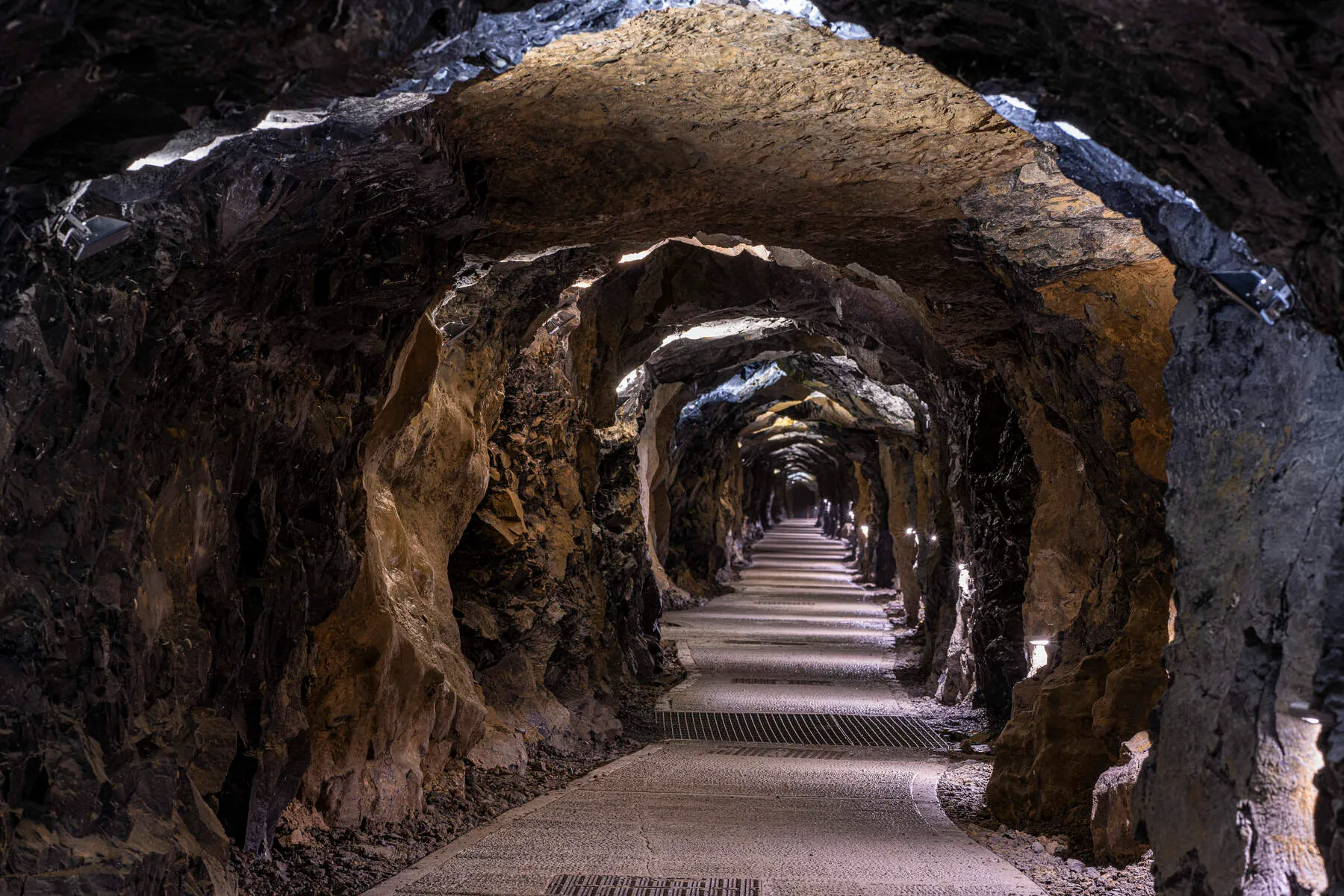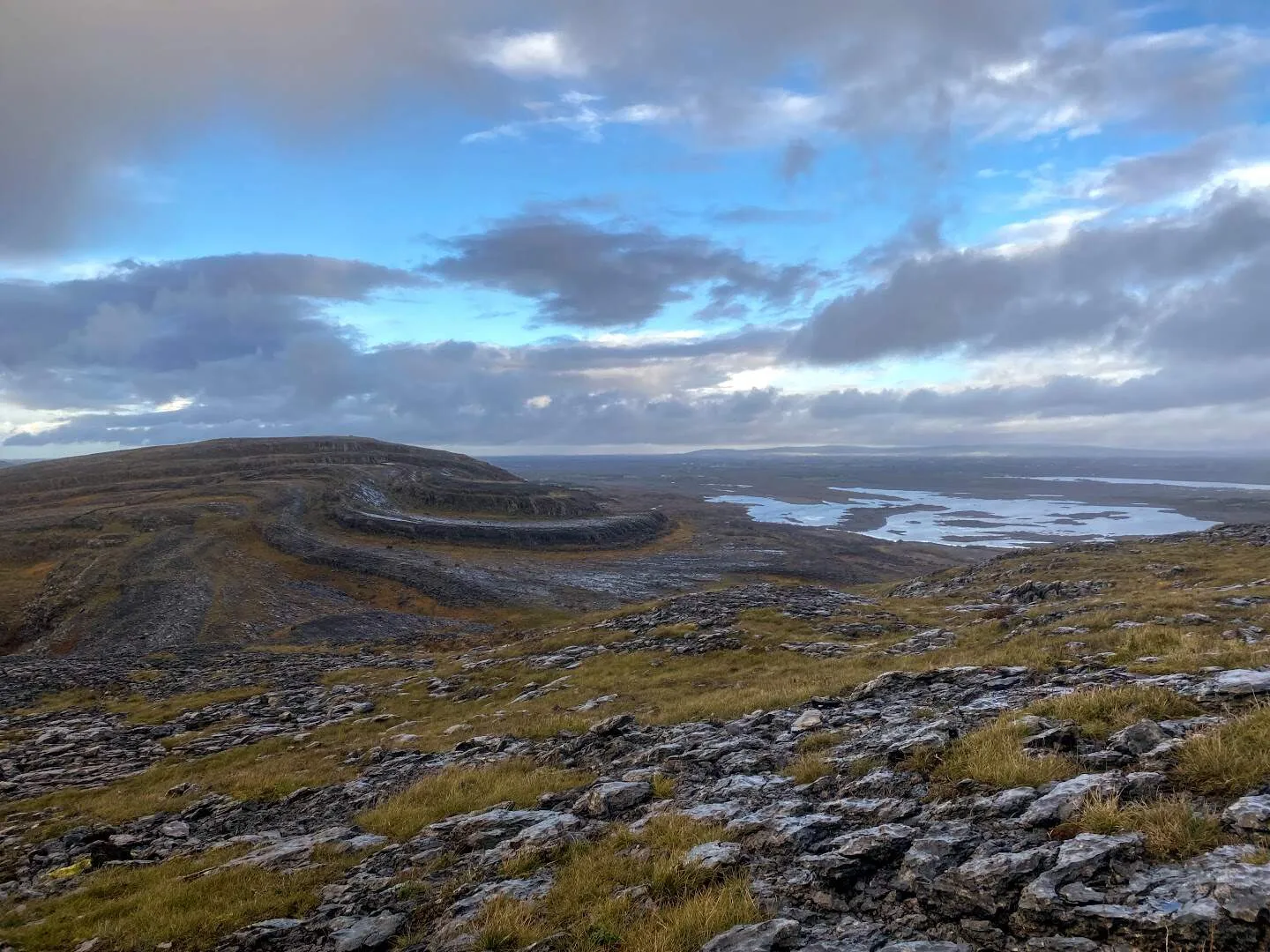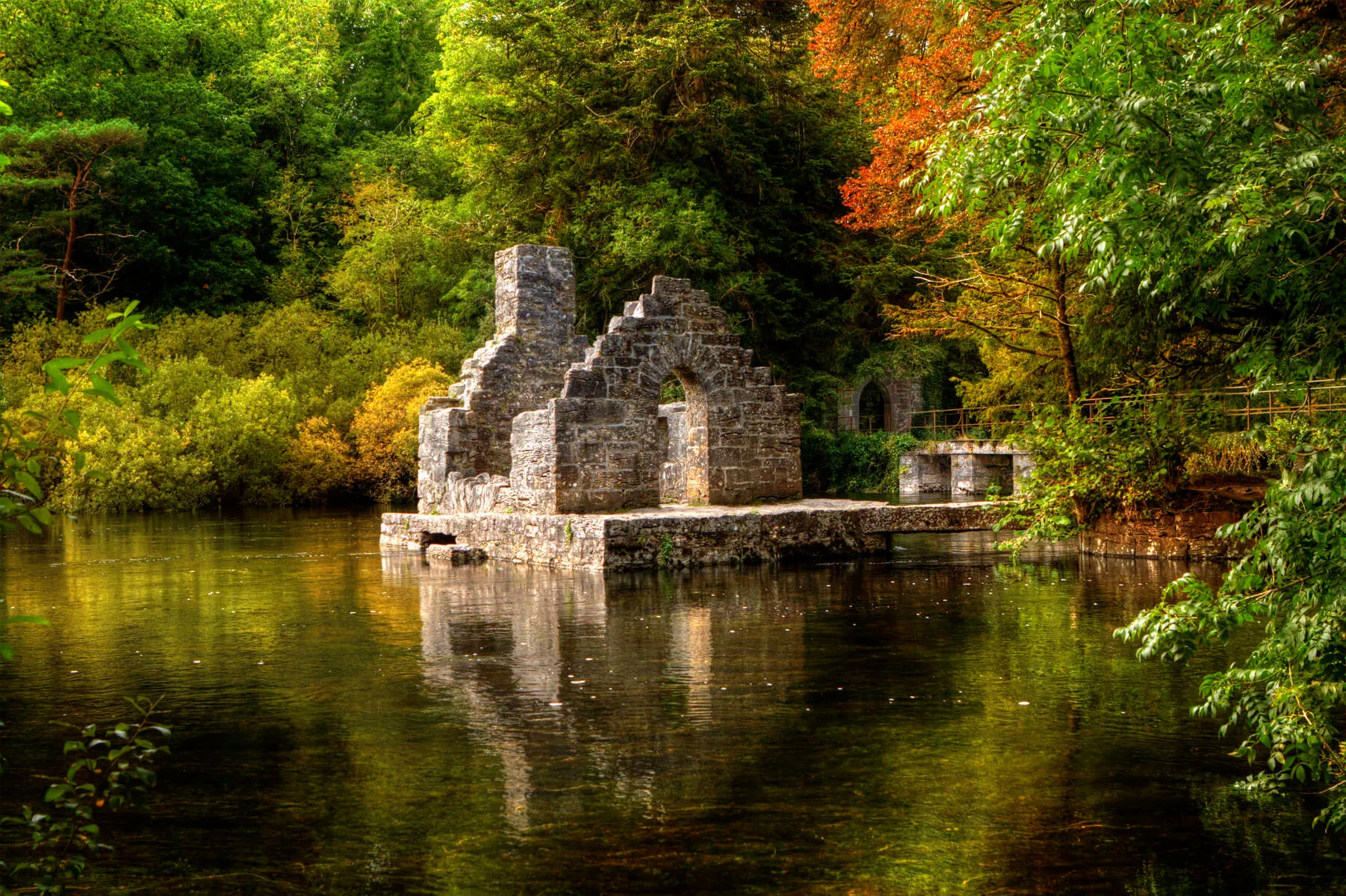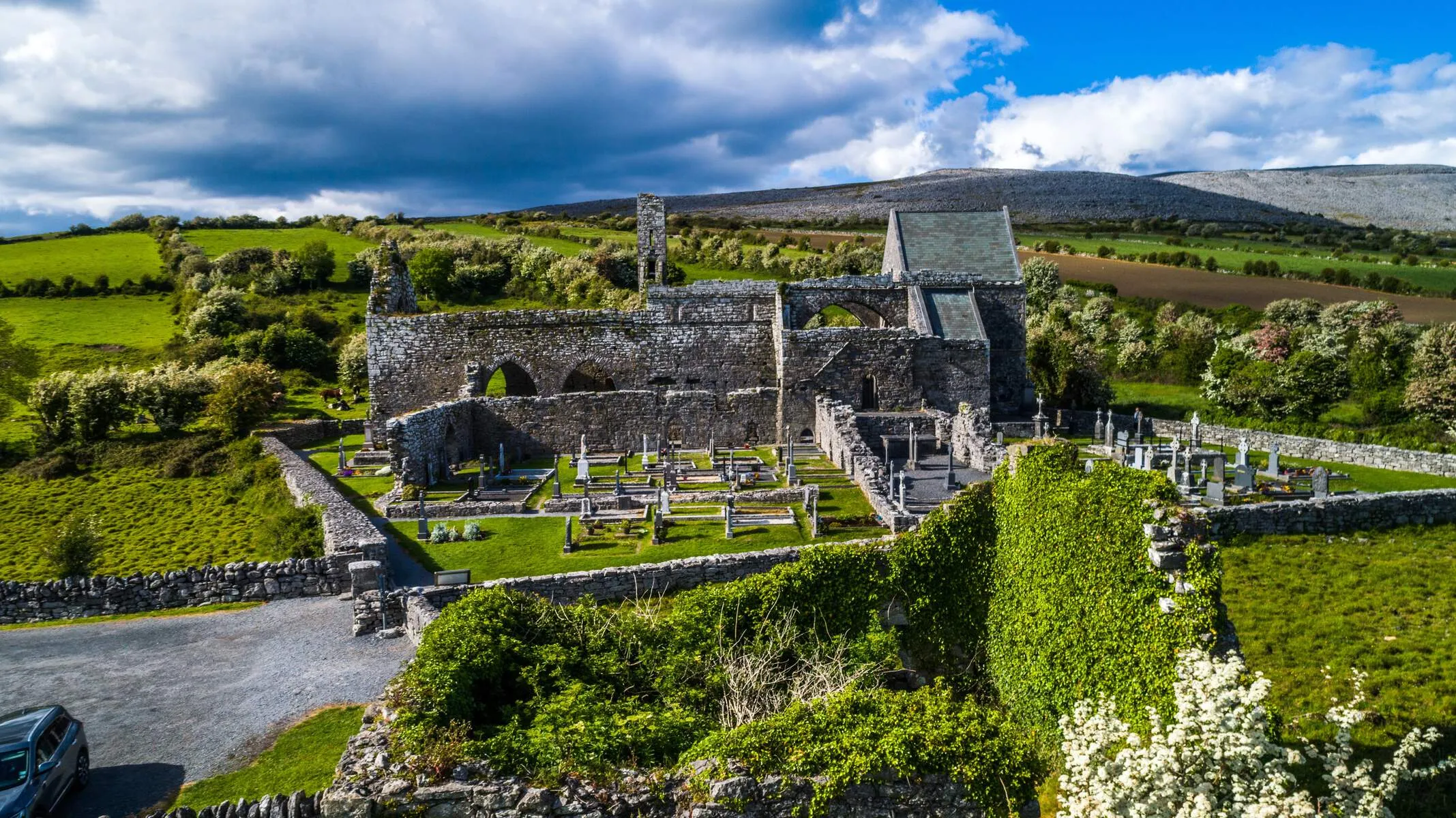Tucked away in Glenaminnagh, a surprisingly green valley within County Clare's stark Burren landscape, sits Corcomroe Abbey. These atmospheric ruins are a powerful link to Ireland's medieval monastic past. Founded sometime between 1180 and 1200 by either Donal Mor O'Brien, King of Thomond, or his son, it became a Cistercian monastery thanks to the powerful O'Brien family. Its Latin name translates to "St. Mary of the Fertile Rock," hinting at the strange contrast of its location – a pocket of rich soil perfect for the monks' self-sufficient life, surrounded by the Burren's famous limestone pavement. While most of the monks' living quarters are gone, the remains of the church – with its arched ceilings, detailed carvings, and the tomb of a king – still speak volumes about its history.
The abbey's design shows the simple style favoured by the Cistercians, but with beautiful artistic touches. Built in the early 13th century, the church has ribbed ceilings, a Romanesque stone seat for the clergy decorated with fine carvings, and column tops adorned with plants like poppies and lilies, alongside mythical figures. The most captivating feature is the tomb of King Conor O'Brien, who died in a family feud in 1268. His limestone effigy shows him crowned and peaceful, set into the wall, showcasing the unique "School of the West" style that blended Romanesque and Gothic details.
Wandering through the ruins today feels timeless. You can see the more elaborate eastern end of the church, with its tall windows, contrasting with the simpler, shortened main body – a sign of the abbey's decline by the 1400s. The site is surrounded by the windswept Burren, and a small, still-used graveyard sits beside the church, showing its lasting connection to the local community. Exploring here is an unguided, peaceful experience, maybe even a little haunting, especially when you know about the local folklore and the Yeats play once performed here. Nearby Oughtmama church ruins and the Flaggy Shore coastal walk offer more ways to explore the Burren's rich history.
Corcomroe is more than just stone ruins. It features in a W.B. Yeats play, and local legends whisper that the original stonemasons were silenced to keep the abbey's unique design secret. For a time recently, Easter Dawn Masses brought the ancient traditions back to life here. The best time to visit is between April and October for milder weather, but the abbey has a special atmosphere at dawn or dusk any time of year, when the light catches the limestone. Whether you're drawn by history, art, or the sheer beauty of the Burren, Corcomroe feels like a place where the past is still very present.
Getting There
Corcomroe Abbey is best accessed by car, though several transportation options cater to diverse travelers. The nearest airports are Galway Airport (GWY), approximately 40 kilometers north, and Shannon Airport (SNN), around 70 kilometers southeast via the N18 and N67. While there are no direct trains to the abbey, the closest rail stations are Ennis (45 km south) and Galway (40 km north), both offering connections to regional bus services.
For drivers, the abbey lies 40 kilometers south of Galway city on the N67, a scenic stretch of the Wild Atlantic Way. Heading west from Ennis on the N67 toward Galway, watch for signposted turns onto Corcomroe Road. From Dublin, the journey takes roughly three hours, following the M7 south to Limerick, then the N8 and N67 westward. Travelers coming from Limerick should take the N18 north to Ennis and continue west on the N67. From Ballyvaughan village, drive 7 kilometers east on the N67 to Bellharbour, then turn right onto the L1016 and follow signs to the abbey-just 200 meters before a short lane leads directly to the site.
Public transportation options include Bus Éireann Route 350, which links Galway and Ennis with a stop at Bellharbour village. From there, it's a 1.5-kilometer walk along a quiet, narrow country lane to the abbey, a route suitable for pedestrians and cyclists. Local taxis in Ballyvaughan or Bellharbour can also arrange drop-offs. No ferry services are required, as all access roads are well-maintained and car-friendly.
Parking
Parking is available at the property, though spaces are limited. The on-site car park is small but sufficient for most groups, and the abbey entrance is just a few steps away, making it a very short walk. Parking here is free of charge, with no fees or payment methods required.
During peak seasons or busy periods, arriving early is advisable to secure a space. If the on-site lot is full, consider nearby alternatives: - Fallon's Bed and Breakfast in Kinvara and The Waters Country House in Ballyvaughan both offer free private parking, with each location within a 20-30 minute drive from the abbey. - The Skeffington Arms Hotel in Galway provides discounted parking at a nearby Q-Park lot, though this option requires a longer drive.
Accessibility accommodations: While there is no designated disabled parking at the abbey itself, visitors with mobility needs may wish to contact nearby hotels for assistance or to arrange parking close to their accommodation.
For spontaneous travelers, street parking in nearby villages like Ballyvaughan or Kinvara may be available during peak times, though spaces are not guaranteed.
Nearby Attractions

Aillwee Burren Experience
Discover the unique landscape of the Burren in County Clare at the Aillwee Burren Experience. Here, you can explore ancient caves, meet birds of prey, and get a taste of local traditions, all surround...
Distance: 7.3 km

Burren Way Walking Trail
The Burren Way Walking Trail is a 114-kilometre long-distance route winding through County Clare's iconic Burren region, a UNESCO-recognised karst limestone landscape formed over 330 million years. Sp...
Distance: 8.0 km

Monks Fishing House
Tucked away beside the River Cong in County Mayo, the Monk's Fishing House is a small stone reminder of clever medieval monastic life. Built sometime between the 15th and 16th centuries by monks from ...
Distance: 16.2 km
